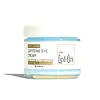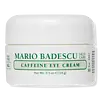What's inside
What's inside
 Key Ingredients
Key Ingredients

 Benefits
Benefits

 Concerns
Concerns

 Ingredients Side-by-side
Ingredients Side-by-side

Water
Skin ConditioningAloe Barbadensis Leaf Juice
Skin ConditioningPropanediol
SolventPersea Gratissima Oil
Skin ConditioningButyrospermum Parkii Butter
Skin ConditioningPolyacrylamide
Caprylic/Capric Triglyceride
MaskingBisabolol
MaskingSodium Hyaluronate
HumectantGlycerin
HumectantZingiber Officinale Root Extract
MaskingCucumis Sativus Fruit Extract
EmollientPhenoxyethanol
PreservativeEthylhexylglycerin
Skin ConditioningCaffeine
Skin ConditioningPolysorbate 80
EmulsifyingMelia Azadirachta Leaf Extract
Skin ConditioningMelia Azadirachta Flower Extract
Skin ConditioningCorallina Officinalis Extract
Skin ConditioningCoccinia Indica Fruit Extract
Skin ConditioningSolanum Melongena Fruit Extract
Skin ConditioningAloe Barbadensis Flower Extract
EmollientSimmondsia Chinensis Seed Oil
EmollientOcimum Sanctum Leaf Extract
Skin ConditioningOcimum Basilicum Flower/Leaf Extract
TonicCurcuma Longa Root Extract
MaskingTocopheryl Acetate
AntioxidantPhytonadione Epoxide
AstringentSaccharide Isomerate
HumectantCitric Acid
BufferingSodium Citrate
BufferingPhytic Acid
Mannitol
HumectantC13-14 Isoparaffin
EmollientLaureth-7
EmulsifyingSodium Hydroxide
BufferingWater, Aloe Barbadensis Leaf Juice, Propanediol, Persea Gratissima Oil, Butyrospermum Parkii Butter, Polyacrylamide, Caprylic/Capric Triglyceride, Bisabolol, Sodium Hyaluronate, Glycerin, Zingiber Officinale Root Extract, Cucumis Sativus Fruit Extract, Phenoxyethanol, Ethylhexylglycerin, Caffeine, Polysorbate 80, Melia Azadirachta Leaf Extract, Melia Azadirachta Flower Extract, Corallina Officinalis Extract, Coccinia Indica Fruit Extract, Solanum Melongena Fruit Extract, Aloe Barbadensis Flower Extract, Simmondsia Chinensis Seed Oil, Ocimum Sanctum Leaf Extract, Ocimum Basilicum Flower/Leaf Extract, Curcuma Longa Root Extract, Tocopheryl Acetate, Phytonadione Epoxide, Saccharide Isomerate, Citric Acid, Sodium Citrate, Phytic Acid, Mannitol, C13-14 Isoparaffin, Laureth-7, Sodium Hydroxide
Water
Skin ConditioningIsododecane
EmollientPentylene Glycol
Skin ConditioningCetearyl Olivate
Sorbitan Olivate
EmulsifyingAmmonium Acryloyldimethyltaurate/Vp Copolymer
Caprylic/Capric Triglyceride
MaskingSqualane
EmollientGlycerin
HumectantCaffeine
Skin ConditioningMaltodextrin
AbsorbentOleic Acid
EmollientPhenoxyethanol
PreservativeSodium Acrylates Crosspolymer-2
AbsorbentHydrolyzed Sodium Hyaluronate
Skin ConditioningChlorphenesin
AntimicrobialTerminalia Arjuna Extract
Skin ConditioningCaprylyl Glycol
EmollientBHT
AntioxidantCetearyl Alcohol
EmollientXanthan Gum
EmulsifyingHydroxyethylcellulose
Emulsion StabilisingCellulose
AbsorbentLecithin
EmollientSilica
AbrasiveCI 77120
Cosmetic ColorantSodium Hyaluronate
HumectantJojoba Esters
EmollientMica
Cosmetic ColorantCI 77891
Cosmetic ColorantWater, Isododecane, Pentylene Glycol, Cetearyl Olivate, Sorbitan Olivate, Ammonium Acryloyldimethyltaurate/Vp Copolymer, Caprylic/Capric Triglyceride, Squalane, Glycerin, Caffeine, Maltodextrin, Oleic Acid, Phenoxyethanol, Sodium Acrylates Crosspolymer-2, Hydrolyzed Sodium Hyaluronate, Chlorphenesin, Terminalia Arjuna Extract, Caprylyl Glycol, BHT, Cetearyl Alcohol, Xanthan Gum, Hydroxyethylcellulose, Cellulose, Lecithin, Silica, CI 77120, Sodium Hyaluronate, Jojoba Esters, Mica, CI 77891
Ingredients Explained
These ingredients are found in both products.
Ingredients higher up in an ingredient list are typically present in a larger amount.
Caffeine is most associated with coffee, tea, and cacao. In skincare, it helps with calming inflammation and is rich in antioxidants.
While caffeine is used to treat cellulite and and dark circles, further studies are needed to prove this. It has been believed to help with these skin conditions due to its ability to dilate blood vessels and increase blood flow.
Some studies are looking into caffeine's ability to protect against UV rays.
Learn more about CaffeineThis ingredient is an emollient, solvent, and texture enhancer. It is considered a skin-softener by helping the skin prevent moisture loss.
It helps thicken a product's formula and makes it easier to spread by dissolving clumping compounds.
Caprylic Triglyceride is made by combining glycerin with coconut oil, forming a clear liquid.
While there is an assumption Caprylic Triglyceride can clog pores due to it being derived from coconut oil, there is no research supporting this.
Learn more about Caprylic/Capric TriglycerideGlycerin is already naturally found in your skin. It helps moisturize and protect your skin.
A study from 2016 found glycerin to be more effective as a humectant than AHAs and hyaluronic acid.
As a humectant, it helps the skin stay hydrated by pulling moisture to your skin. The low molecular weight of glycerin allows it to pull moisture into the deeper layers of your skin.
Hydrated skin improves your skin barrier; Your skin barrier helps protect against irritants and bacteria.
Glycerin has also been found to have antimicrobial and antiviral properties. Due to these properties, glycerin is often used in wound and burn treatments.
In cosmetics, glycerin is usually derived from plants such as soybean or palm. However, it can also be sourced from animals, such as tallow or animal fat.
This ingredient is organic, colorless, odorless, and non-toxic.
Glycerin is the name for this ingredient in American English. British English uses Glycerol/Glycerine.
Learn more about GlycerinPhenoxyethanol is a preservative that has germicide, antimicrobial, and aromatic properties. Studies show that phenoxyethanol can prevent microbial growth. By itself, it has a scent that is similar to that of a rose.
It's often used in formulations along with Caprylyl Glycol to preserve the shelf life of products.
Sodium Hyaluronate is hyaluronic acid's salt form. It is commonly derived from the sodium salt of hyaluronic acid.
Like hyaluronic acid, it is great at holding water and acts as a humectant. This makes it a great skin hydrating ingredient.
Sodium Hyaluronate is naturally occurring in our bodies and is mostly found in eye fluid and joints.
These are some other common types of Hyaluronic Acid:
Learn more about Sodium HyaluronateWater. It's the most common cosmetic ingredient of all. You'll usually see it at the top of ingredient lists, meaning that it makes up the largest part of the product.
So why is it so popular? Water most often acts as a solvent - this means that it helps dissolve other ingredients into the formulation.
You'll also recognize water as that liquid we all need to stay alive. If you see this, drink a glass of water. Stay hydrated!
Learn more about Water